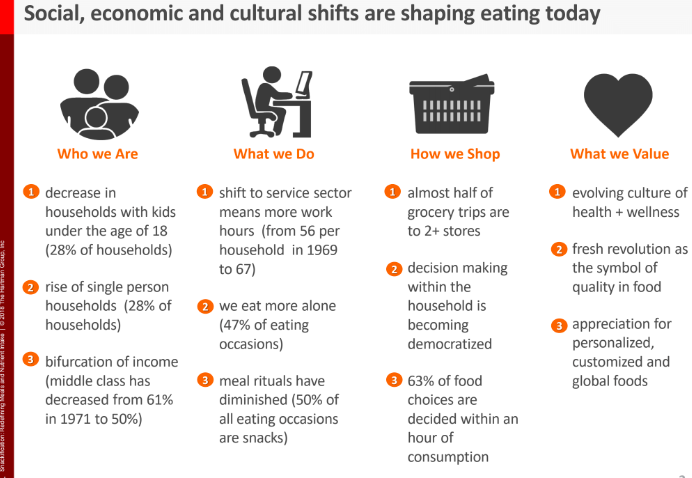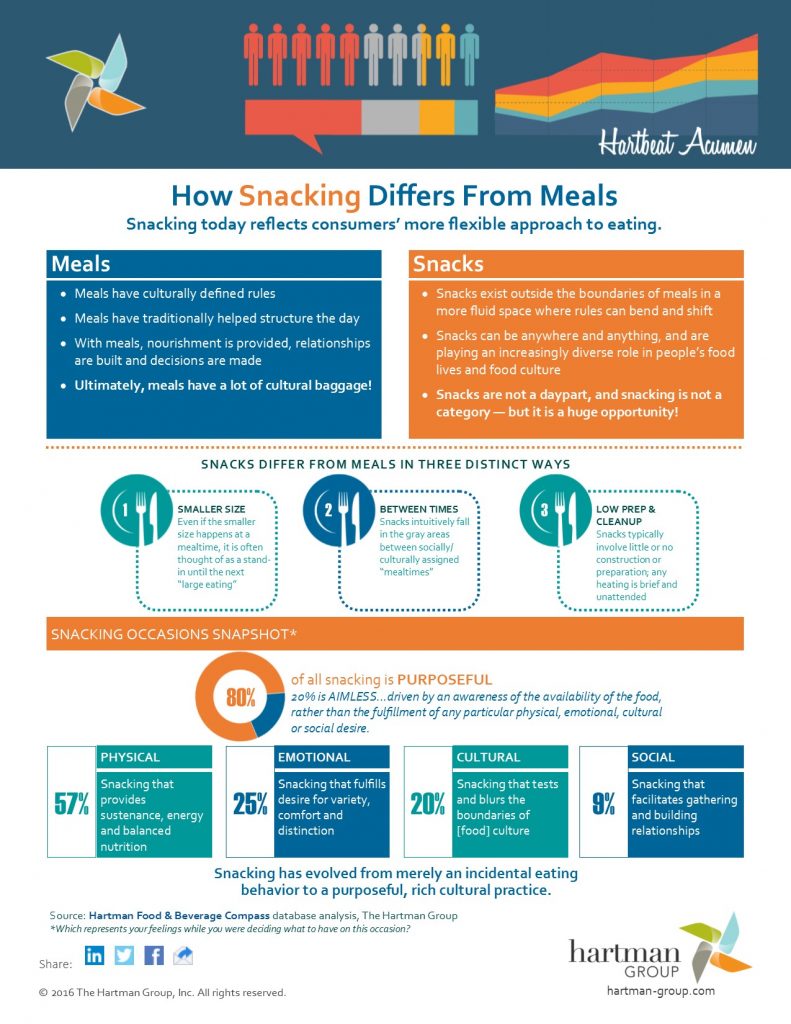Bush Beans sponsored a continuing education session about consumer meal and snack data, but did not pay for this post. My thoughts and opinions here are my own.
It seems that Americans continue to idealize a traditional mealtime routine, even though eating rarely happens that way. I recently attended a conference session, sponsored by Bush Brothers & Company, that addressed the topic of meals and snacks. Consumer data was presented showing how meals have been redefined over the years, and how proper snacks may help fill nutrient gaps.
Even though it’s 2019, many of us may still think that including a “sit down meal” in your day is important when it comes to healthy eating styles. I am one of those people. I do believe there is a lot that can happen (beyond nutrition) when people sit together at a table and share food. Several studies have suggested that children do better in school and engage in less risky habits when families sit down regularly to share a meal. But the reality is, people aren’t doing it.
Rather than try to convince you to schedule better mealtimes, and cook more meals at home, I’m going to go with the flow. Understanding that you simply don’t have the time or energy to make meals happen every day, I want to help you make better snack choices – and maybe even work on “planned family snack time” as well (look for more tips in next week’s post).
What is a Snack?
Defining a “meal” or “snack” can be tricky. Let’s take a look at some typical definitions of meals and snacks, and some of the recent consumer data on eating styles.
The standard definition of “meal” is – “an act or the time of eating a portion of food to satisfy appetite”.
A snack is defined as “a light meal; food eaten between regular meals”.
The terms are a bit fuzzy. What people actually perceive a snack to be can vary too. For instance, to me, a slice of toast with peanut butter is a meal (breakfast) but to someone else, it’s a snack. Since eating and drinking can happen anywhere at any time of the day, snacking has become a popular eating style. New data suggests that people are sitting at the table less and less at home.
What Shapes Our Food Choices?
Lots of things shape the way people eat and the food choices they make. Surprisingly, even though many pictured the “ideal family mealtime” of the early 20th century as one where the whole family sits together eating a home-cooked-from-scratch-meal, it really didn’t happen that way for most. Flash forward to the 21st century, and you see a rise in single person households, with only 28% of households having children under age 18, and a smaller middle class. This demographic results in more people eating alone, with less meal rituals. Grocery shopping routines have changes as well. Rather than one large trip that plans out a whole week, people are shopping as needed with 63% of food choices decided within an hour of consumption.

Image and data from The Hartman Group, “Snackification” FoodFluence Presentation, Pew Research Center data included, used with permission
Even though you may dream about eating “3 meals a day and cooking them from scratch”, reality looks more like this –
Breakfast: skipped, or grabbing leftovers or a bar
Lunch: Catered at work, or a fast casual pick up
Dinner: Skipped at work, or eaten out
The History of Eating
Current eating habits actually look more like those of the Native Americans and early Colonists, who simply ate when they were hungry (snack-like foods such as berries or nuts) often while walking or standing. It was during the Industrial Revolution of the mid 1800s that we began sitting at a formally set table, where conversation became an art, as did table-settings. During WWII snacks became an expression of American freedom, as soldiers enjoyed rations of chocolate bars, and food companies were actively marketing new “fun foods”.
According to the Hartman Group, 91% of consumers snack multiple times throughout the day, with an overall 50% of eating coming from snack occasions. Forty-two percent of Millennials (and 30% of all consumers) say that snacking allows them to try out global flavors. Millennials also use snacks as a source of fuel pre- or post-workout. The data suggests that several factors are at play that have resulted in the snack habit – time pressures, competing commitments, lack of cooking skills, changes in wellness and culinary trends (nutrition, wanting to try new foods), and the sheer availability of food that enables constant choices, and consumption. The result – about 42% of consumers are replacing meals with snacks. Other less healthy snack habits happen too, with 22% of all snacking being aimless (due to boredom or to cope with stress).

Image from The Hartman Group, “Snackification” FoodFluence Presentation, Pew Research Center data included, used with permission
It’s suggested that Americans will spend 200 billion dollars on snacks in the year 2020. Coincidentally, the Dietary Guidelines for Americans (DGA) will be reviewed and updated at that time. Since Americans are consuming so much of their food via snack time, it will be a good idea to create guidelines for snacking that are consistent with the DGA. People want healthy snacks that are easy to prepare and make them feel good (i.e., not a “guilty indulgence” but rather, a nutritious choice). Food companies are working to meet this new “healthier snack” goal, by providing more options that offer better nutrition, calorie control, and convenience.
Moving toward Nourishment and Optimization
People are looking for snacks for three main reasons:
- Nourishment (key nutrients, managing appetite)
- Optimization (energy, mid-day pick me up, fueling a workout
- Pleasure (comfort, reward, new flavors)
Moving toward the goals of nourishment and optimization when choosing snacks may be the answer to improving overall nutrition, weight management, and health goals. Perhaps you can view snacks more like “mini-meals” and not indulgences.
The next time you think you need a snack, consider why you think you need it. Give snack time more thought, and plan snacks that can fill important nutrition needs, help you manage hunger (and weight), and support your overall health goals.




